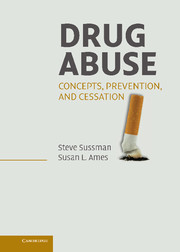Book contents
- Frontmatter
- Contents
- Preface
- Acknowledgments
- SECTION ONE CONCEPTS AND CLASSES OF DRUGS
- SECTION TWO ETIOLOGY
- SECTION THREE PREVENTION
- 10 Concepts of Prevention
- 11 Neurobiologically Relevant
- 12 Cognitive Processes
- 13 Social Interaction and Social Groups
- 14 The Large Social and Physical Environment
- SECTION FOUR CESSATION
- SECTION FIVE CONCLUSIONS AND THE FUTURE
- References
- Author Index
- Subject Index
10 - Concepts of Prevention
Published online by Cambridge University Press: 18 December 2009
- Frontmatter
- Contents
- Preface
- Acknowledgments
- SECTION ONE CONCEPTS AND CLASSES OF DRUGS
- SECTION TWO ETIOLOGY
- SECTION THREE PREVENTION
- 10 Concepts of Prevention
- 11 Neurobiologically Relevant
- 12 Cognitive Processes
- 13 Social Interaction and Social Groups
- 14 The Large Social and Physical Environment
- SECTION FOUR CESSATION
- SECTION FIVE CONCLUSIONS AND THE FUTURE
- References
- Author Index
- Subject Index
Summary
This chapter defines and discusses key concepts and program methods that have evolved with increased understanding of the complexity of substance use behavior and its prevention. In an effort to improve program effectiveness, and as a result of findings from evidence-based prevention programs, prevention interventions are now often designed for use in a particular setting or settings and tailored to address the needs of specific groups. Moreover, different prevention programs target persons across the life span (young children, elementary school youth, teens, emerging adults, adults). The use of interactive techniques (e.g., role-play, peer discussions) has been found to increase involvement in the learning process while reinforcing skills training and may be a sin quo non for prevention efficacy (see Botvin et al. 1995; Sussman et al., 1995; Sussman, Rohrbach, Patel, & Holiday, 2003; Tobler et al., 2000). This chapter also provides a discussion of the importance of reinforcing prevention goals with repeated interventions or booster programs, long-term follow-up, and worldwide reach of prevention efforts.
Prevention Definitions and Classifications
Historically, public health researchers and practitioners have divided the field of prevention programming into three levels. These levels are primary prevention (before the problem behavior starts), secondary prevention (before the disease starts), and tertiary prevention (before death is likely). However, new terms are now being used to further differentiate various levels of prevention programming.
- Type
- Chapter
- Information
- Drug AbuseConcepts, Prevention, and Cessation, pp. 139 - 154Publisher: Cambridge University PressPrint publication year: 2008



